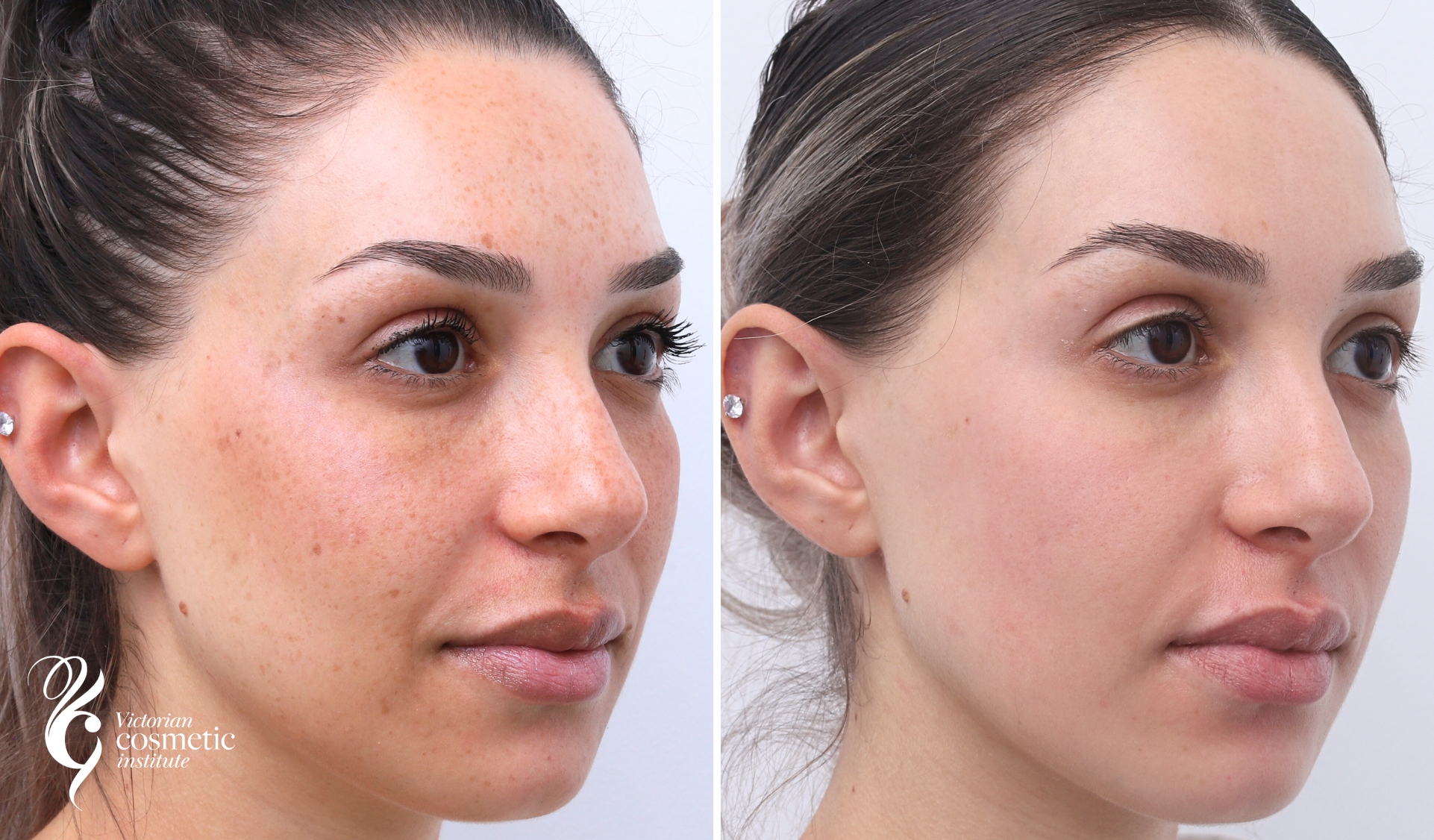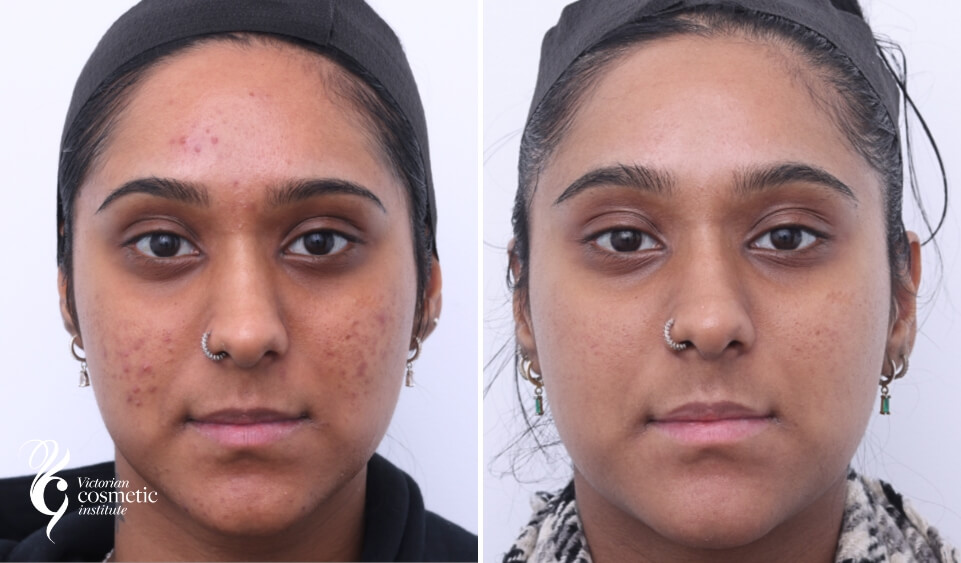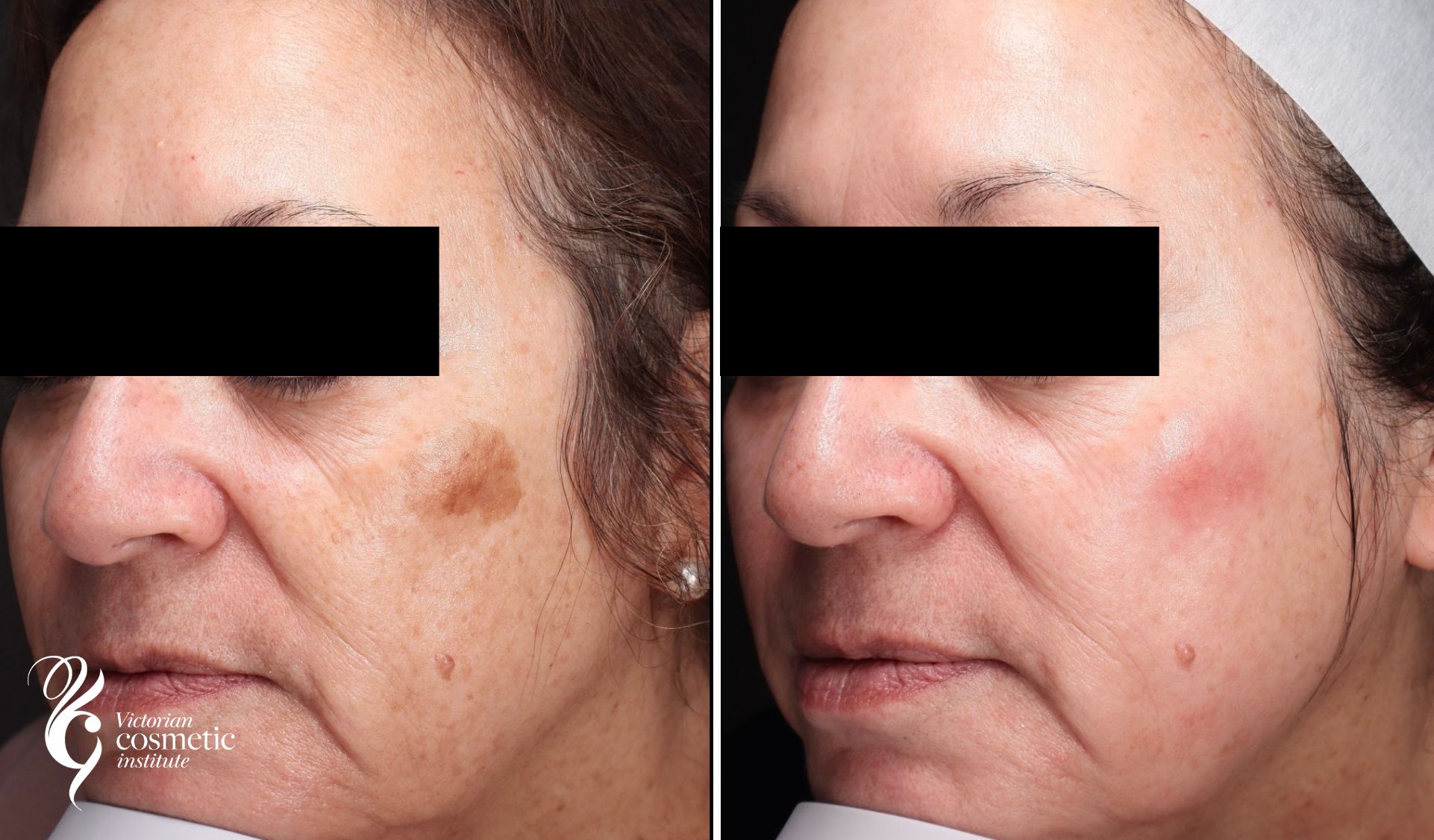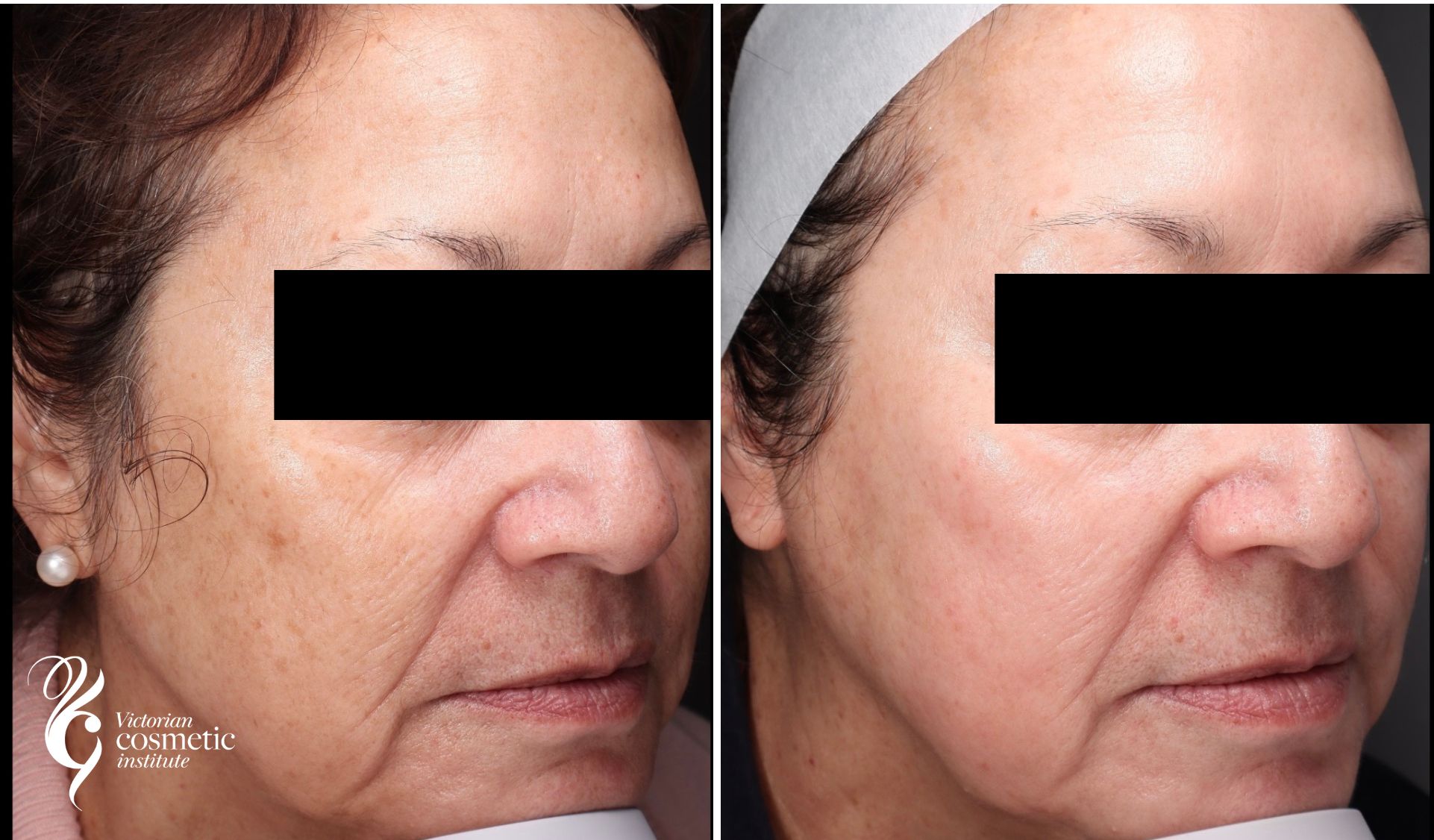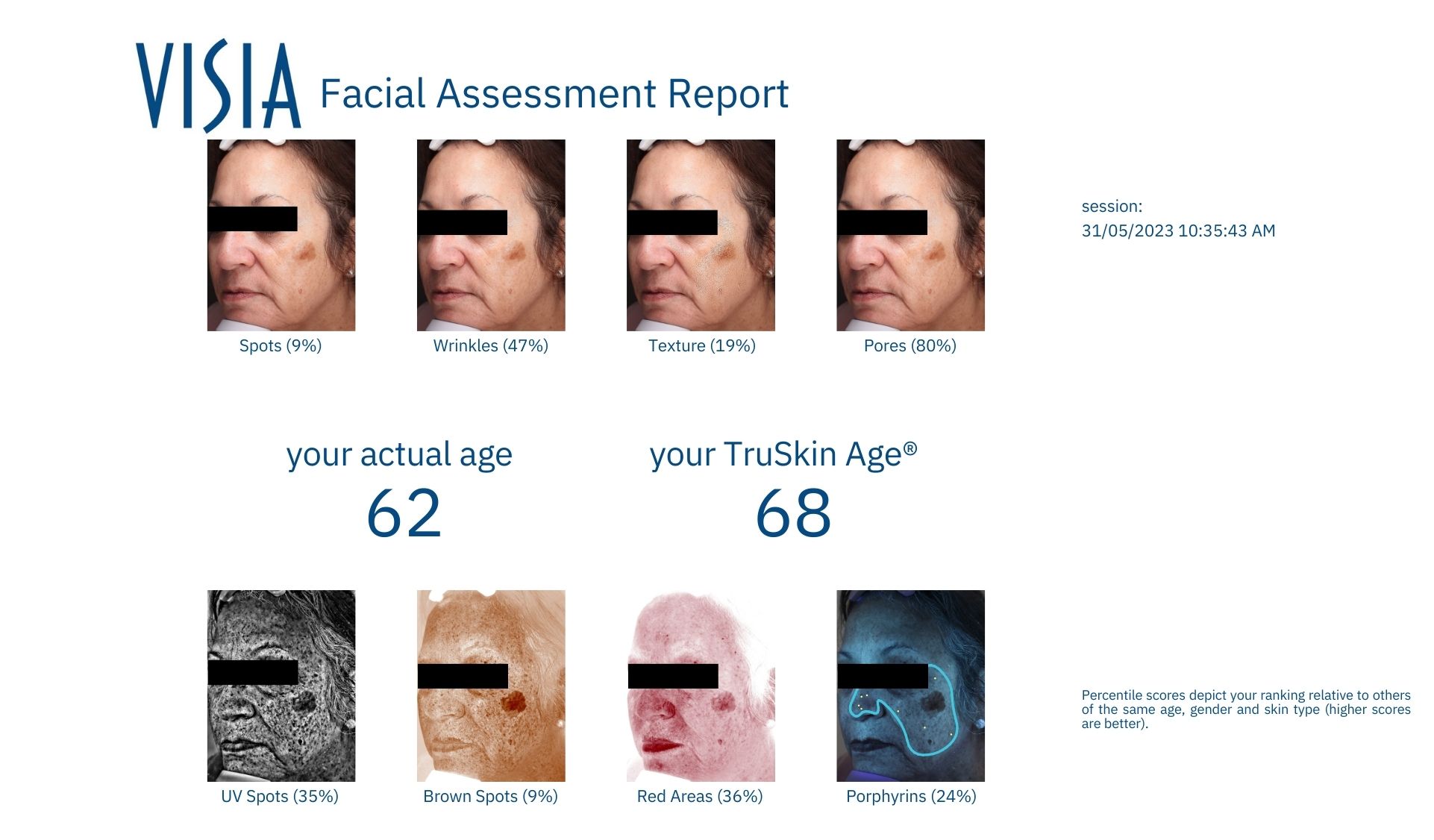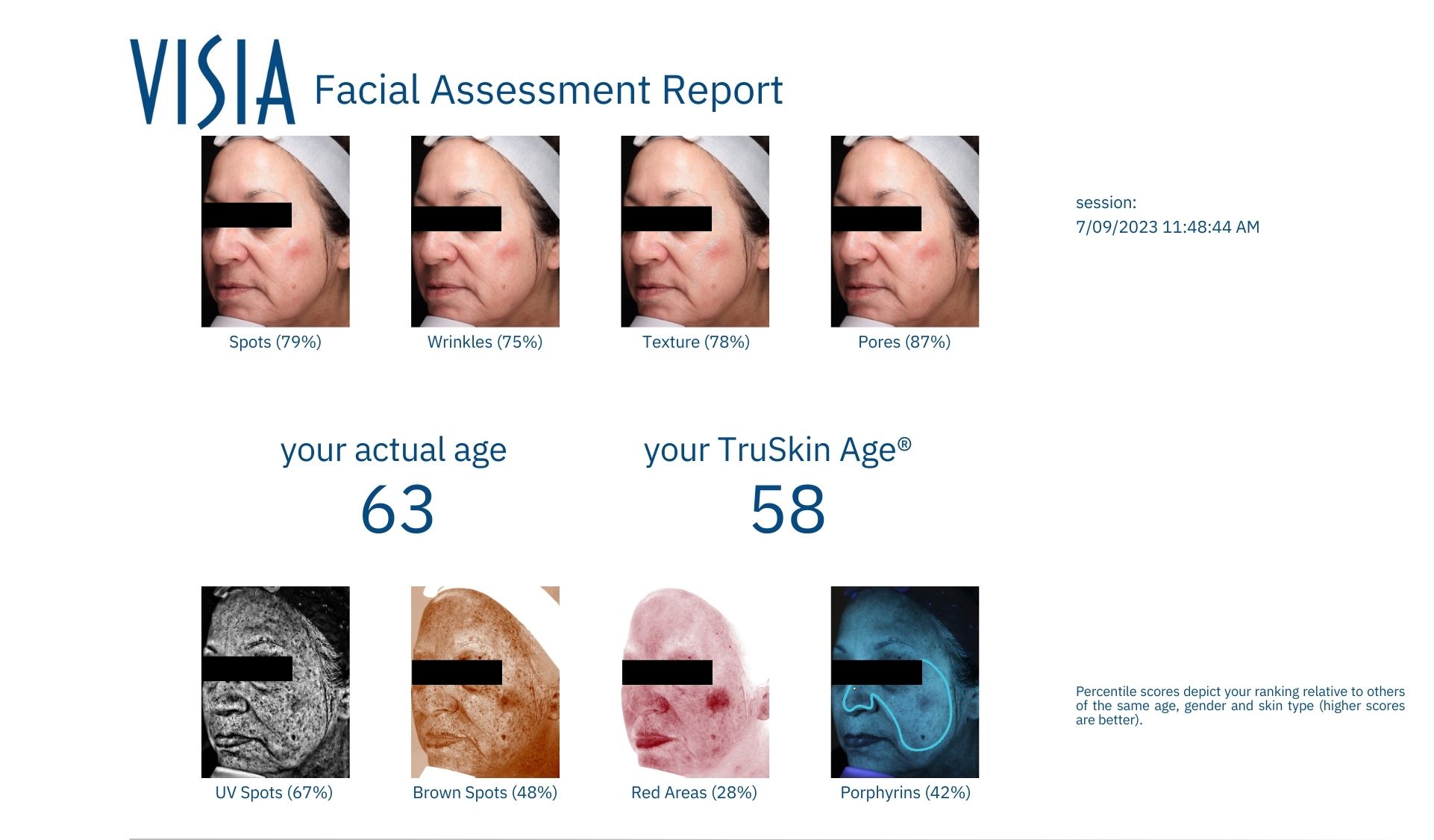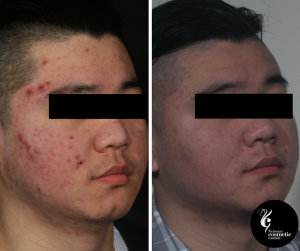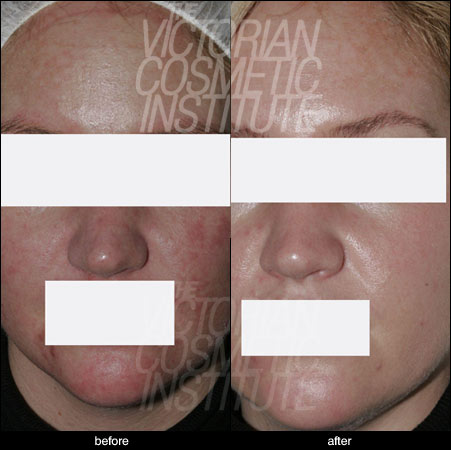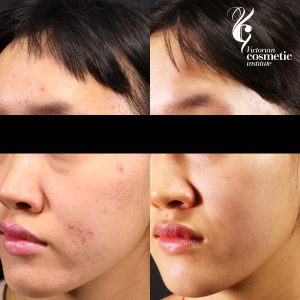Last updated September 2023
What are chemical peels?
Chemical peels are a method of regenerating and resurfacing the skin by inducing a controlled wound to the skin. They remove the top layer’s skin to help induce collagen remodelling and therefore improve sun-damaged skin, skin pigmentation problems, wrinkles, skin texture, and the overall appearance of the skin.
There are also several types of chemical peels, ranging from superficial to deep. Each type of peel is suited to different skin types and their concerns.
What are the benefits of a chemical peel?
There are many reasons why someone may choose to get a chemical peel, especially when the benefits to the skin are numerous and long-lasting. Aside from revealing a brighter and smoother complexion, they also improve the appearance and texture of the skin. The exact benefits of treatment depend on the skin concern being targeted, which may be:
- Acne scars – Chemical peels can help to reduce the appearance of acne scars by exfoliating the top layers of the skin and promoting the growth of new, smoother skin. Some acne scars may find additional treatment through skin needling like RF microneedling or pen needling beneficial to removing all traces of scarring.
- Acne or oily skin – Acne-prone or oily skin can find chemical peels helpful in unclogging pores, reducing oil production and fighting bacteria present.
- Fine lines and wrinkles – The appearance of fine lines and wrinkles can be reduced through chemical peels as the treatment stimulates collagen production and promotes skin cell turnover.
- Uneven skin tone – Chemical peels can help to even out skin tone by reducing the appearance of dark spots, sun damage, and other discolourations.
- Dull or rough skin texture – Rough skin texture can be addressed during treatment to reveal smoother, more radiant skin.
- Enlarged pores – Chemical peels can help to minimise the appearance of pores, adding to the improvement of the overall texture and appearance of the skin.
- Hyperpigmentation – By breaking down excess melanin in the skin, chemical peels can reduce the appearance of hyperpigmentation.
- Sun damage – Chemical peels can help to reverse the signs of sun damage, including fine lines, wrinkles, and discolourations.
- Melasma – The appearance of melasma, a type of hyperpigmentation that typically occurs on the face, can be lessened with treatment.
- Overall skin rejuvenation – Chemical peels can help to refresh and rejuvenate the skin, leaving it looking brighter, smoother, and more youthful.
Knowing what kind of skin concerns you wish to be treated for before getting a chemical peel can help your skin therapist determine which treatment will benefit your skin the most.
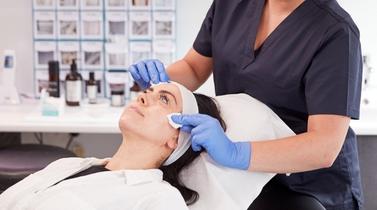
What types of chemical peels are there?
There are several types of chemical peels each suited to different skin problems and types. Chemical peels are classified as superficial, medium or deep chemical peels, according to the level of skin they reach. Below is an example of some of the peels available at the Victorian Cosmetic Institute.
Superficial peels
Alpha-hydroxy acid (AHA) peels
The Cosmedix AHA Antioxidant Therapy Peel and Lactic acid peel treatment are two AHA peels that can be applied at various concentrations to vary the strength of the peel.
Cosmedix AHA Antioxidant Therapy Peel, also referred to as Cosmedix Pomegranate Peel 15% L-Lactic, is an antioxidant peel specially designed to even out the top layers of the skin. It does so by mildly exfoliating the surface of the skin as potent antioxidants work to prevent free radical damage. These cells often hold surface pigmentation, are responsible for uneven skin tone and contribute to fine lines. During the AHA peel, these cells are exfoliated away and the skin is forced to generate new cells. A series of these peels increase the efficiency of cell regeneration and remove rough surface cells. Downtime after treatment is usually minimal and it is suitable for all skin types.
Meanwhile, the Synergie self-neutralising peel is a lactic acid peel that both exfoliates and moisturises the skin. This is done by removing the top layers of the skin and inducing new collagen formation. It does not encourage strong peeling, yet it still gives all the effect of a full-strength peel with only 2-3 days of minimal side effects. Depending on the skin issues you are dealing with and their severity, you can choose from different strengths of lactic acid. Options include: Enzyme Hydro Peel 15% Lactic Peel, Lactic 20%, Lactic 30%, and Lactic 40%.
Beta-hydroxy acid (BHA) peels
The Synergie self-neutralising treatment is a salicylic acid (BHA) peel. These peels are generally used to treat acne-prone, oily or blemished skin as they are oil soluble and penetrate deeper in this type of skin environment. Salicylic acid works by penetrating the follicles removing trapped oils and dead cells, while also reducing inflammation within the skin. The treatment requires around 5 days of recovery. Those with olive or darker skin types are not recommended to use higher concentrations of Beta-hydroxy acid peels.
For active acne, there may be some post-peel purging. As the acid exfoliates away the surface of your skin, it brings clogged pores you have underneath, closer to the top, which may erupt as more active pimples. Read here for more information on which skin care products are suitable for oily skin.
Retinoic acid peels
Our cell turnover in our skin slows as we age. Retinoic acid increases the turnover rate of the skin and makes it behave like ‘younger skin’ again. This treatment can also help to reduce DNA mutations caused by UV exposure on the skin by stimulating collagen production, inhibiting the growth of harmful bacteria, restoring the immune system, improving circulation, and sealing in moisture deep within the skin.
Due to its many benefits, Retinoic acid peels are used for resurfacing, to treat sun damage, acne, wrinkles and skin texture. A delay of 2-3 days will occur after treatment before the skin starts to peel, which usually lasts for 4-5 days. Click here for more information on the benefits of Vitamin A for the skin.
Modified Jessner’s peel
The Modified Jessner’s peel is a combination of 14% lactic acid, 14% salicylic acid, and 14% resorcinol, with the addition of Kojic acid. This combination peel brings together a combination of alpha and beta hydroxy acids that heightens the effects of each of these ingredients. Resorcinol is a derivative of phenol (a very deep peeling agent) and is ideal for resurfacing the skin, the depths of which are determined by the number of layers placed on the skin. Although in most cases this is generally superficial, the peel can still stimulate the deeper dermis level of the skin and causes new fibroblasts and collagen to develop, puffing out lines and wrinkles caused by ageing.
The skin may turn a frosty white colour after treatment for a short while, but its benefits of also treating sun-damaged skin, hyperpigmentation and aiding in the healing of acne outweigh this temporary appearance change. Read our article for more information on how to treat pigmentation with skin care.
Trichloroacetic acid (TCA) peel 10-20%
Commonly referred to as TCA peels, these peels have been performed for many years. A TCA peel exfoliates the skin at a dermal level, improving skin texture, wrinkles and pigmentation. It is also suitable for treating enlarged pores and acne scars. Due to the nature of the treatment, clients may require 7-10 days of downtime. Most clients only require 1 treatment, however for more problematic skin, it is recommended to do 2-4 peels over 12 months. As the formation of new collagen requires time, the results will continue to improve for 6 to 12 months after the treatments.
Dermaceutic peels
These professional peels consist of five targeted chemical treatment systems.
- Milk Peel (Glycolic acid 50%, Lactic Acid, 10% Salicylic acid) – A milk peel regulates oil and reduces the appearance of pores, evens skin tone, and improves the appearance of fine lines and wrinkles. Mild peeling is possible around day 2-3 after treatment, but generally, no downtime is necessary. It is a suitable treatment for before an event or function.
- Mask Peel (Glycolic 30%) – A mask peel tightens pores, regulates oil and brightens the skin, making it ideal for acne and congested skin. The skin may have some slight peeling post-treatment, but this usually occurs after 2-3 days and lasts just as many.
- Mela Peel Forte – A two-step treatment that improves dull complexion, and reduces the appearance of melasma, pigmentation and PIH, while also brightening the skin. Step 1 is the application of an Activa Peel, followed by the Mela Peel Forte. This peel is classified as a medium-strength peel, thus it is important to check that the patient is thoroughly prepped on pigment inhibitors for skin types Fitzpatrick 4 and above.
- Cosmo Peels (12%, 15% and 18% strength) – Another two-step treatment option, a cosmo peel improves the appearance of wrinkles, skin texture, skin irregularities, smoker’s complexion, pigment disorders, and signs of ageing. It requires the initial application of TCA, followed up by Cosmo Peel Cream.
- Cosmo Peel Forte – A stronger version of the Cosmo Peel, classified firmly within the realm of a strong-strength peel. This works much like the Cosmo Peel to improve the overall appearance of the skin, including wrinkles, texture, irregularities, pigment disorders, signs of ageing and a smoker’s complexion. Due to this strength, the patient must be thoroughly prepped on pigment inhibitors for skin type Fitzpatrick 4 and above.
Medium depth chemical peels
Trichloroacetic acid (TCA) 35%
Medium chemical peels with 35% Trichloroacetic acid are an effective treatment that targets skin texture, fine lines, wrinkles and pigmentation. A medium-depth TCA peel exfoliates superficial wrinkles while also working well on depressed scars. The procedure stimulates the production of new skin cells and reveals healthier-looking skin. TCA peels are a cost-effective alternative to laser resurfacing.
Deep chemical peels
Laser skin resurfacing
Deep chemical peels using laser skin resurfacing may achieve better results with more control over the depth of treatment and may increase collagen remodelling.
Cosmelan peel program
Cosmelan peel is an intensive peel treatment for pigmentation concerns such as melasma, sun damage, post-inflammatory hyperpigmentation and freckles for all skin types. The Cosmelan peel cannot be performed independently and must be provided as a treatment program with pre-treatment preparation products and post-treatment care. There are a minimum of 4 treatment appointments and at home skin products that must be used as part of the Cosmelan peel program.
Which chemical peel is right for me?
Chemical peels induce a controlled wound to the skin and can replace part or all of the top layers of it. The key determinants of which chemical peel is right for you are:
- Degree of the skin problem
- Ageing
- Sun damage
- Skin type/colour
- Amount of improvement you would like to achieve
- Amount of recovery or downtime that is acceptable to you
Darker skin types
As a rule, the deeper the peel, the more side effects, potential complications, and recovery are needed. Another rule of thumb is that the darker the skin type, the more problems that may be encountered post-peel, especially problems such as post-inflammatory hyperpigmentation where the treated skin may become darker than the untreated skin. Therefore, deeper peels in darker skin tones must be considered with caution and sometimes it may be better to perform a series of more superficial chemical peels rather than one deep peel.
Skin ageing concerns
The degree of skin ageing will also determine which peel to use. For younger patients with less sun damage, pigmentation and wrinkles, a superficial peel may be required. The opposite is also true.
Acne skin types
Different skin problems also respond to particular peels. Acne, for example, responds well to Jessner’s peel and salicylic (beta-hydroxy acid) peels. BHA peels and Jessner’s peels are very oil soluble and can penetrate deeper into pores and remove oil and sebum and are anti-inflammatory. Both alpha-hydroxy acid and beta-hydroxy acid peels help exfoliate the skin.
Pigmentation and sun damage concerns
TCA peels, alpha-hydroxy acid peels, and Jessner’s peels are suited to pigmentation problems and severe sun damage.
Wrinkles and fine lines
Wrinkles can be best treated with TCA peels or any medium to deep chemical peel. These peels can be a cost-effective alternative to laser resurfacing. A course of Retinoic peels to complement other skin treatments is also a common treatment plan.
For the body
Parts of the body other than the face can be peeled also. For example, you can have chemical peels on the chest and back for acne, or on the neck and décolletage to help reduce sun damage.
What other skin treatments can be combined with a chemical peel?
The intent of getting a skin peel treatment is to remove damaged skin cells to make way for newer, healthier ones. However, optimum results for your skin may be achieved by adding other skin treatments that directly address your skin concerns. Skin treatments that can be combined with a chemical peel include:
- LED light therapy – Best used directly after a chemical peel treatment within the same appointment for optimal results. LED Light Therapy offers different types of light therapy, with skin concerns like acne, scarring and inflammation capable of being treated. Using this skin treatment directly after a chemical peel can help remove the last traces of particularly deep acne scars or discolouration.
- Bio-remodelling – Using bio-remodelling treatment post-peel may help to encourage the ‘well-being’ of your cells. The skin’s quality, firmness and elasticity are targeted for improvement, with final results intending to hydrate your skin once more, along with the clarity offered by peel treatment.
- Bio stimulator injectors – You can increase collagen production by utilising this treatment after your peeling skin has cleared up. The improvement to your collagen production works particularly well on ageing skin, helping to smooth out wrinkles and fine lines and overall improve skin elasticity.
- Wrinkle treatment – Soften the lines on your face for a more even texture and a brighter complexion, or use it as a preventative method to prevent further static lines from forming.
Utilising post-treatment skincare may also help improve your skin after a chemical peel. Regularly applying sunscreen and reducing sun exposure is also very important as it protects the new skin and prevents it from being damaged.
How to prepare for a chemical peel
Patients must prepare their skin on a skin care program designed by your practitioner. This is to ensure your skin is protected and to minimise any complications or side effects. It will also provide optimal results from your treatment.
Skin priming can be achieved by using skin care products containing retinoic acid or topical lightening agents such as hydroquinone, kojic acid or arbutin. Priming must begin at least 2 weeks or more before a chemical peel to help with uniform penetration of the peel and accelerate healing. It can also reduce post-peel complications such as post-inflammatory hyperpigmentation.
Using cleansers and/or exfoliants in the weeks before chemical peeling can also help the peeling agent. However, direct sun exposure should be avoided before the treatment, and solariums or skin tanning should not be used. Your Skin Therapist or Nurse will advise which products are best to prepare your skin before treatment.
What to expect during a chemical peel
The skin is thoroughly cleansed with an appropriate cleanser first. A masking agent is sometimes used to protect the peel from entering the eye. A fan may be present to help cool the skin for comfort during the peel. Your eyes should be closed during the procedure.
The chemical peel solution is then applied to the face. The procedure is timed, and you will be asked about your comfort level. Depending on the peel that is used, neutralisation of the peel may occur at the end of the treatment. This ensures the chemical peel does not stay active on the skin for longer than necessary.
The chemical peel is usually completed by placing sunscreen and a soothing balm on the face.
What will my skin look like after the treatment?
Following a chemical peel treatment, the appearance of these skin concerns will be reduced. Depending on the condition’s severity, you can choose how intense you wish your treatment to be.
You can choose a lower-strength peel for a touch-up the day before an event. Flaking is minimal and generally only apparent after day 3. This can be gently exfoliated with an enzyme cleanser to remove dead skin cells.
In turn, higher-strength peels may cause flaking sooner and are not recommended before an event. This treatment is intended for long-lasting results, which can be optimised by using medical-grade skincare after treatment.
How to care for the skin after a chemical peel
Specific aftercare will be discussed with your practitioner. However, each patient is advised to avoid sun exposure following treatment and use sunscreen daily. If you are using active ingredients in your skin care routine, let your practitioner know and they will advise when to resume use.
Other requirements for proper care of your skin include:
- Not using skin care containing AHA, salicylic or retinol until your skin has completely healed.
- Not picking at your face and avoid rubbing the face with your hands or towels.
Your practitioner will advise when you can commence using mineral makeup after treatment.
Don’t touch your face
As your dead skin may shed and flake after your treatment, try to avoid peeling this off with your fingers, as it can lead to possible scarring. Let the dead skin shed naturally.
Pull your hair back
Keeping your hair out of your face can limit touching and breakouts. It’s important to allow the skin to heal naturally, without accidentally touching your skin when brushing your hair back. Touching the skin with dirty hands and fingers can affect the development of new skin and may also lead to breakouts. If breakouts do occur, see a skin specialist to treat them for you, alternatively, do not touch the breakouts.
Cleanse with cool water
Using hot water after your treatment can cause inflammation. Use cool water to cleanse your face and gently pat your skin dry afterwards – avoiding rubbing the face.
Moisturise your skin and limit sun exposure
After a chemical peel, your skin will be sensitive. There may be some products in your skin care routine that you will want to avoid, as they have active ingredients that may irritate the skin during its healing process. Two products that you will want to use during the healing process are sunscreen and a moisturiser.
It is recommended to limit sun exposure post-treatment and practice sun safety when outdoors. This includes wearing a hat, wearing protective clothing and using sunscreen.
We also recommend a soothing balm to hydrate the skin. When applying your moisturiser, be careful not to rub it in, instead gently apply a thin layer all over your face when needed, throughout the day. Once the peeling process is complete and your skin no longer feels sensitive, you can go back to your usual skin care routine.
Your Skin Therapist or Nurse will advise you on which products you should use and avoid post-treatment.
Let the skin peel
Do not forcibly remove the dead skin, refrain from rubbing, pulling or peeling the skin during the healing process. As the skin is very sensitive in the healing process, it is best to stop exfoliation, until the skin is healed.
Facial scrubs, skin resurfacing acids, retinol and cleansing brushes should not be used until the skin has stopped shedding – this may take up to a week or more post-treatment.
Who is a suitable candidate for a chemical peel?
Only patients who have had a consultation and have sufficiently prepared their skincare can have peels. Patients must also be over 18 to have chemical peels or 16+ with a parent present.
Patients who are breastfeeding or pregnant may not be capable of having most chemical peel treatments.
Who is not a suitable candidate for a chemical peel?
Patients with a history of, or a current infection of herpes simplex virus (cold sores) should ensure that their Skin Therapist or Nurse is aware of this before chemical peeling. If there is an active infection present, you may be asked to wait until it has passed before having a chemical peel. Even if you do not currently have a cold sore, a history of the condition may require your doctor to prescribe an antiviral medication as a prophylaxis to an outbreak during your treatment.
Other potential non-suitable candidates include those who have:
- A history of keloid (thick, pigmented scars), as all but the most superficial of peels may not be possible
- HIV/AIDS or immunosuppression as treatment may impair wound healing and increase the likelihood of infection and scarring
- Had a course of oral Isotretinoin or Roaccutane in the past 6 months, especially before undergoing medium or deep chemical peels
- Had a face or brow lift in the past 6 months
What are the risks associated with chemical peels?
As a rule, the deeper the peel, the higher the rate of complications and the longer the recovery. Most superficial peels are safe and effective, whereas medium and deep peels require more experience from the operator and more careful pre-peel preparation and post-peel care. For medium peels like the 20% TCA peel, the downtime can vary from a few hours to a week.
The risks associated with chemical peels include:
- Swelling – usually lasts up to three days but is usually only associated with the deeper peels.
- Pain – is only seen with the deeper peels and may last only a few hours.
- Redness – Most superficial peels produce a mild redness that persists for only a few days. Medium to deep peels can cause redness lasting up to a month.
- Itchiness – This is only common after medium and deep chemical peels.
- Ocular injury – Care must be taken during the procedure to avoid the peel from entering the eye.
- Allergic reactions – are uncommon, although peels such as the Jessner peel have a higher allergy rate. Antihistamines may be taken before, if an allergy is known, or after.
- Folliculitis/acne – occurs commonly due to the emollient creams used during healing. Antibiotics may be required to heal these eruptions.
- Bacterial/fungal infection – though uncommon, it can lead to scarring. This is usually only associated with medium to deep peels.
- Herpes simplex recurrence – This is a common reaction and needs to be treated with antiviral medication to prevent spread and scarring.
- Hyperpigmentation – Dark patches may form over the deeper parts of the peel and result from inflammation causing the release of melanin/pigmentation from the skin. This is usually temporary, although it can last for up to 2 years. Treatment usually involves a lightening agent such as hydroquinone.
- Hypopigmentation – A loss of pigmentation can occur in darker skin types after peeling. This can be permanent sometimes.
- Telangiectasia – Small red vessels under the skin can form and become more prominent with peeling. The vessels are easily treated with lasers such as the Gemini laser.
- Milia – Small white cysts that form about 2 to 3 weeks after the skin has re-epitheliased (grown over) can manifest. It can be due to blockage of the skin due to emollient creams used after chemical peeling. They can be removed with a needle or lancet.
- Demarcation lines – This is usually a result of medium to deeper peels, and the line where the peel was used and the new skin is noticeable even after the skin has healed.
- Scarring – A very uncommon complication of chemical peels usually associated with a history of poor healing or keloid scarring. Scarring is more likely the deeper the peel. An early sign of scarring is persistent redness and itchiness. This needs to be treated with a topical steroid.
How can I minimise the complication rate from chemical peels?
Patient selection is an essential part of reducing the rate of complications. Complications can be minimised by choosing the right peel for each particular skin type whilst considering the patient’s needs. Darker-skinned patients, particularly those of European, Asian, or African backgrounds, are more prone to pigmentation problems (either a gain or loss of pigmentation) after a medium to deep chemical peel.
It is possible to prepare the skin beforehand with hydroquinone and tretinoin, which help to reduce the rate of post-inflammatory hyperpigmentation (dark areas) post-peel. This is particularly important for medium/deep peels and darker-skinned patients. This regime can be continued after the peel (2 weeks after) to reduce pigmentation problems further.
Similarly, sun exposure pre- and post-peel should be avoided or at least minimised. Sun exposure can lead to an increase in pigmentation problems also.
FAQ
What does each of the different depths of chemical peel achieve?
Superficial peels remove the upper layers of the skin and can help smooth and revitalise the skin.
Medium-depth peels are ideal for those with sun-damaged skin or premature signs of ageing. They can also improve superficial wrinkles, and remove uneven pigmentation, sunspots and brown spots.
Deep peels can also help with sun-damaged skin and wrinkles but have since been replaced with laser skin resurfacing, which offers similar results but with better safety and control.
How many sessions do I need?
This will depend on your aesthetic goals, treatment and your treatment plan. If you have concerns about acne or sun-damaged skin, multiple sessions may be required.
How long until I see results?
The length of time, before your results appear, depends on the skin type, skin concern and chemical peel selection. Most chemical peels require a series of treatments to see results.
Is downtime required for a chemical peel?
Depending on the chemical peels used, there are different downtimes experienced. For most peels, this can include side effects like mild redness and flaking.
In contrast to most other types, if you have a retinoic peel, you will have to leave it on your skin for several hours. This will result in a slightly yellow appearance as well as a lot of facial peeling as this is a resurfacing peel. Your peeling should not last more than a week.
Is a chemical peel painful?
Generally, a chemical peel is not painful, but you may experience a slight tingling sensation, a change in temperature or skin tightness. You may also experience slight sensitivity post-treatment.
How much does a chemical peel cost?
This will depend on the type of chemical peel. To see the current pricing for a chemical peel, click here.
Is it safe to get a chemical peel during pregnancy?
There are a limited number of peels that are safe to have during pregnancy. Although your peel options are limited, we do have several facial options available.
Why should I choose the Victorian Cosmetic Institute as my provider of chemical peels?
At Victorian Cosmetic Institute, our team of Skin Therapists and Nurses have many years of success in treating various skin types and skin concerns using chemical peels. Our thorough skin consultations ensure that your treatment plans are tailored specifically to you.
We prepare your skin with care over several weeks before having a chemical peel as our products are stronger than a salon’s and we care for our patients. Our consultation and preparation process ensures we reduce the risk of adverse outcomes such as chemical burning.
If you are requiring deeper treatment using the TCA chemical peel or skin lasers you will require a consultation with one of our Cosmetic Nurses. Our Cosmetic Nurses will be able to give you the proper advice on the right treatment for you.
Making that first phone call to book a consultation can be a confronting task – many of our patients have preferred to book their consultation online. We can then contact you with an understanding of the results you are hopeful of achieving and ensure the treatment is appropriate before booking your consultation appointment.
You can book online or phone our Customer Care team directly on 1300 863 824.
